
Luang Prabang
Luang Prabang is the ancient town situated in northern Laos. In 1995, it was declared a UNESCO World Heritage site. The global body described it as an outstanding example of the fusion of traditional architecture and Lao urban structures with those built by the European colonial authorities in the 19th and 20th centuries. Its unique, remarkably well-preserved town scape illustrates a key stage in the blending of these two distinct cultural traditions.
- Location: north central Laos, about 300 kilometers north of Vientiane
- Population: 408,800 people (2004) Area: 16,875 square kilometers
- Status: former capital of Laos
- Name meaning: Royal Buddha Image
- Name variant: Chiang Thong
- Highlights: the tidiness and cleanliness of the city, night market at the end of the main street, many natural and historical sites
Once tourists coming LuangPrabang, their curious will be waken up by the Alms Giving Ceremony. It takes place daily as the sun rises, beginning on the main street of LuangPrabang before spreading out to all the side streets. Saying goodbye with the monks, tourists will continue their journey to many famous destinations in LuangPrabang. As you know, LuangPrabang is considered as citadel of Laos.
This beautiful town is a collection of historical and majestic constructions. The most typical one in this collection is WatXieng Thong which was built in 1560. There are many legends about the place where the Nam Khan enters the Mekong. It is believed to be the site where the two hermits, who founded LuangPrabang, placed the boundary stone for the new settlement.
Another story tells about a betel merchant with the name of Chanthapanit who built a palace on this site, making himself the first king of the new capital. It has been said that he was the first founder of WatXieng Thong. Besides WatXieng Thong, Royal Palace Museum is a worthy place for s visit. Presently, it displays things that were used during the reign such as gifts from neighboring countries.
If tourists feel satisfied with your discovery around historical buildings, waterfalls are the next interesting choice for you. For a long time, LuangPrabanghave been famous for Tad Sae or Kuang Si waterfall. They are really spectacular natural wonders best appreciated in the wet season. In general, LuangPrabang is a must see destination in the world. There are so many hidden beauties in this town that we can not list all. Let’s contact with us to have exciting journey in your life.
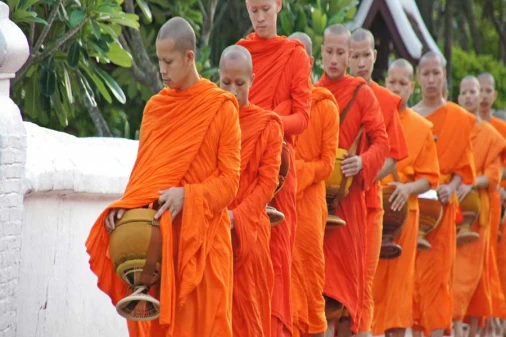
Alms Giving Ceremony
The UNESCO World Heritage City of Luang Prabang is the perfect place to see one of the most sacred Lao...
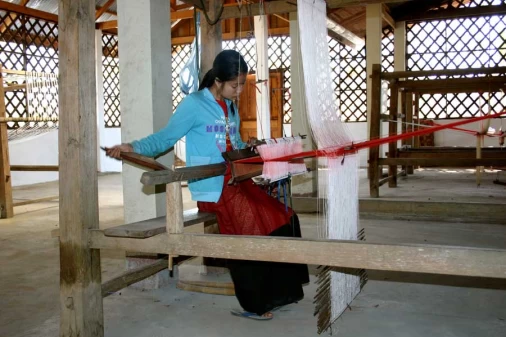
Ban Phanom
Ban Phanom is a village steeped in traditional textile making with all families in the village working...
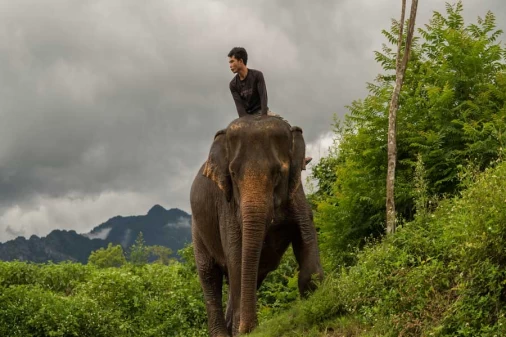
Elephant Village Sanctuary
Close to the banks of the Nam Khan River, the Elephant Village Sanctuary (also known as the Elephant...
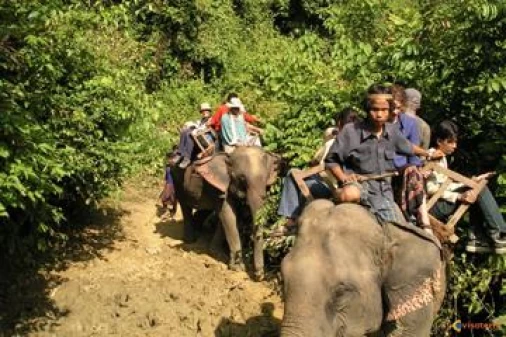
Elephant VIllage Santuary
Location: The Elephant Village Sanctuary is situated in the village of Xieng Lom 15km southeast of Luang...
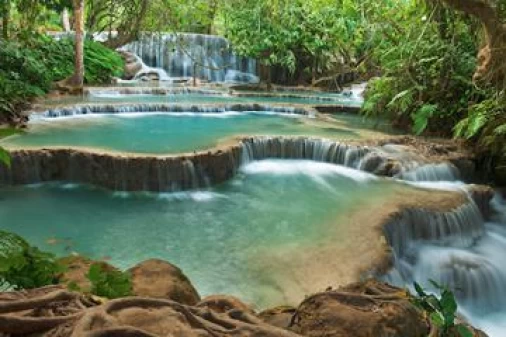
Kuang Sii Fall
Situated at about twenty miles from Luang Prabang, this is a large waterfall and can be reached by Touktouk...
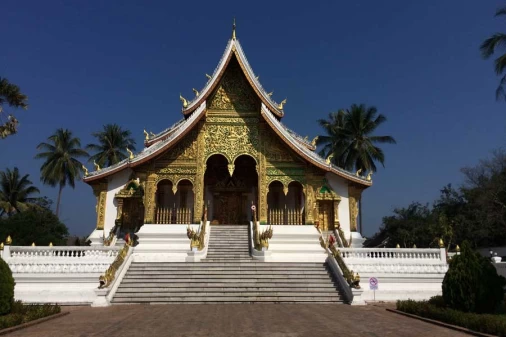
Luang Prabang Library
The Luang Prabang Library is a wonderful place to visit and offers the chance for you to give something...
Frequently asked questions
It’s a mesmerising city filled with over 33 temples, vibrant nightlife, stunning nature, and so much more, which is why it’s the country’s first UNESCO World Heritage Site.
There are a lot of top things to do in Luang Prabang, and each one is more memorable than the last.
Luang Prabang is also the ancient royal capital of Laos, so there is a lot of history in this region too.
1.Relax at Kuang Si Waterfall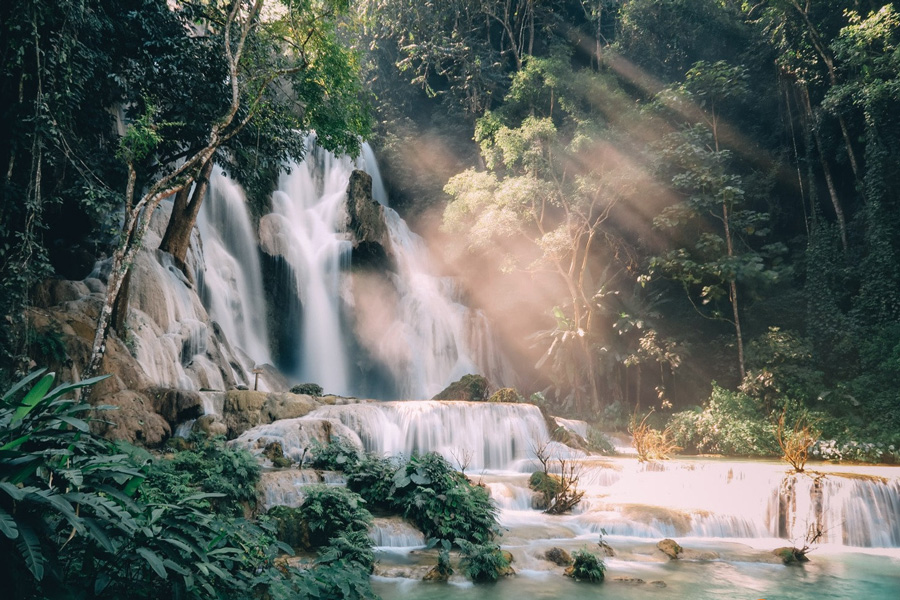
Laos may be a landlocked country, but it sure has some of the finest waterfalls in the region.
Although the waterfalls themselves aren’t in the city, they’re definitely worth the trip to get there.
It’s not easy to describe how falls look like, because they’re a gorgeous mix of azure and turquoise, and they cascade in an entirely beautiful way.
At times, they feel as if they’re the sky in liquid form, especially when they’re crashing down on the rocks.
You can also hike to the top of the waterfalls, and even stand inside the waterfall itself.
Proper footwear is absolutely required if you plan on making any excursions to the top, but there is nothing to worry about because there’s a fence about a meter away from the lip of the falls.
2.Experience the majestic temples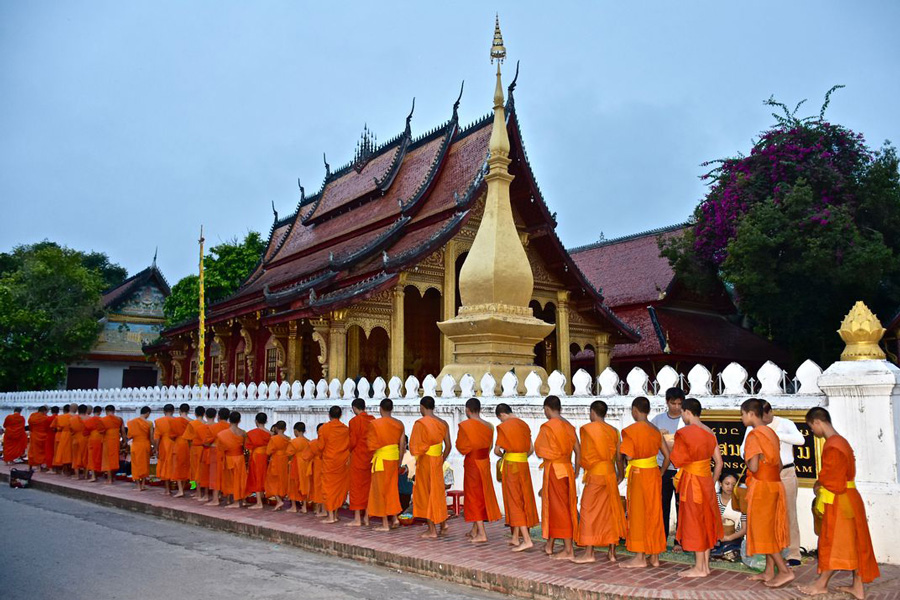
There are plenty of attractions in Luang Prabang but most of them pale in comparison to the stunning golden temples.
There are 34 active temples in the city, and all of them are beautifully gilded which gives Luang Prabang a deep spiritual feel.
They’re known as Wats, and they’re known to have a very relaxing and soothing atmosphere, especially when you’re walking through its gold and burgundy grounds.
The most famous temple is called Wat Xieng Thong, which was built in the 1500s, and it’s one of the finest places to visit in Luang Prabang.
Wat Xieng Thong is a well-known spot where you can rest and meditate, and search for Nirvana, but even if you’re just visiting you won’t regret seeing its beauty in person.
However, if you’re intent on visiting the temples, make sure to know the customs and proper etiquette.
They’re still active institutions, and sometimes it’s possible for locals and monks to be offended if you’re not following some guidelines.
Dressing properly is one of the most important guidelines for the temples, which generally means to have arms and legs covered.
Some temples might have a couple of extra rules, so be sure to ask before visiting.
3.Enjoy the famous night markets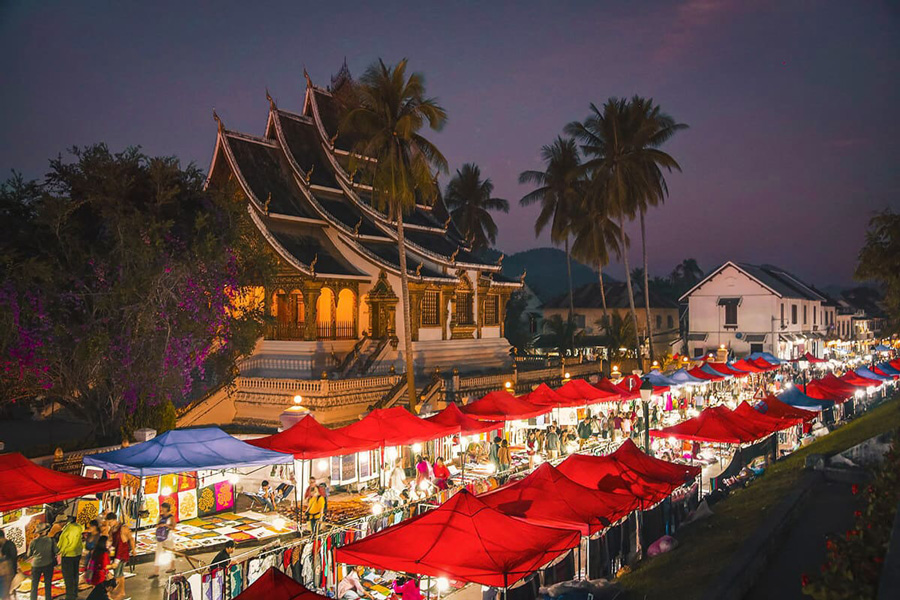
One of the things that South East Asia is most known for is its markets, and Luang Prabang has one of the best in the entire region.
They’re located in the centre of the town, and they’re very vibrant, colourful, and lovely.
Here is where you’ll easily find the spirit of Laos concentrated in one spot because it’s filled with people from several different regions around Luang Prabang.
Many of the goods that are for sale on the stalls are handcrafted.
There are plenty of different items on sale depending on the season, ranging from simple wood carvings to ornate jewellery and trinkets.
This spot tends to be quite crowded, and even though Luang Prabang already feels lively, the crowds give the city an extra sense of life.
Even if you don’t have any intentions of shopping, simply taking photographs of the place can feel amazing.
Another thing that no traveller should skip out on is grabbing a bite to eat.
Just off the main road of the market you can find the buffet street, which is a laneway filled with really good authentic food.
The buffet street even has communal seating, so it’s very easy to meet another like-minded traveller, and to make new friends.
4.Watch the Alms Giving Ceremony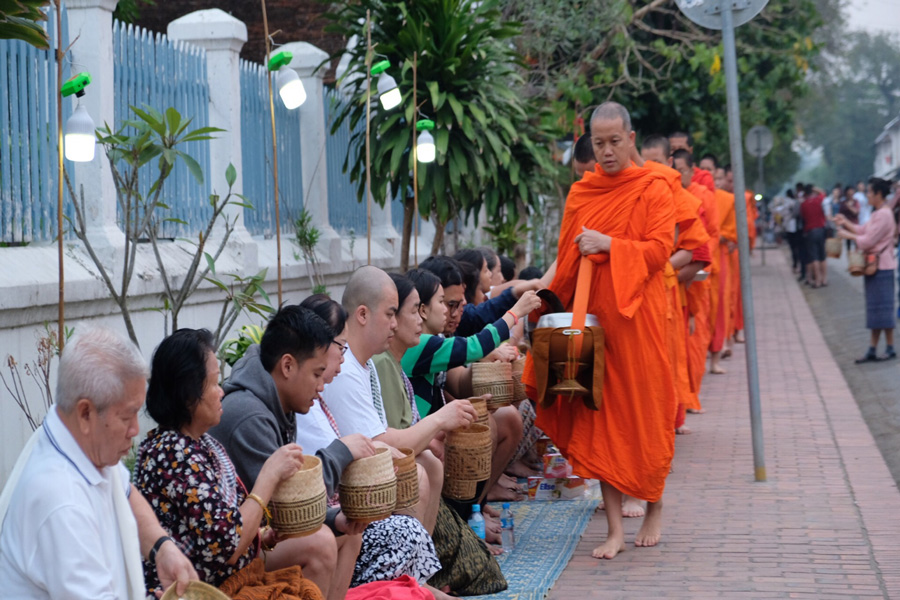
Spirituality and religion play a deep role in the country of Laos, and there are plenty of old traditions that are still being practised to this very day.
Starting from the 14th century, local monks leave their respective temples at sunrise in order to collect alms for them to be able to help feed the poor.
This is a ceremony that actively encourages visitors to participate, which is why it’s one of the best things to do in Luang Prabang.
The ceremony itself starts from the main street of the city, then it moves on to many of the side streets of Luang Prabang.
Since the ceremony starts at sunrise, it’s best to be there before the monks arrive because it’s considered rude and disrespectful to take part in the tradition after it has begun.
Clothing and general appearance are also important – having your chest, legs, and shoulders covered is a sign of respect.
Offerings generally include food, such as rice, fresh fruit, or traditional sweets, and they are to be presented respectfully with a bow.
It’s a lovely tradition, one that perfectly showcases just what Lao culture is all about, and it has an unforgettable serene atmosphere about it.
5.Hike up to Mount Phou Si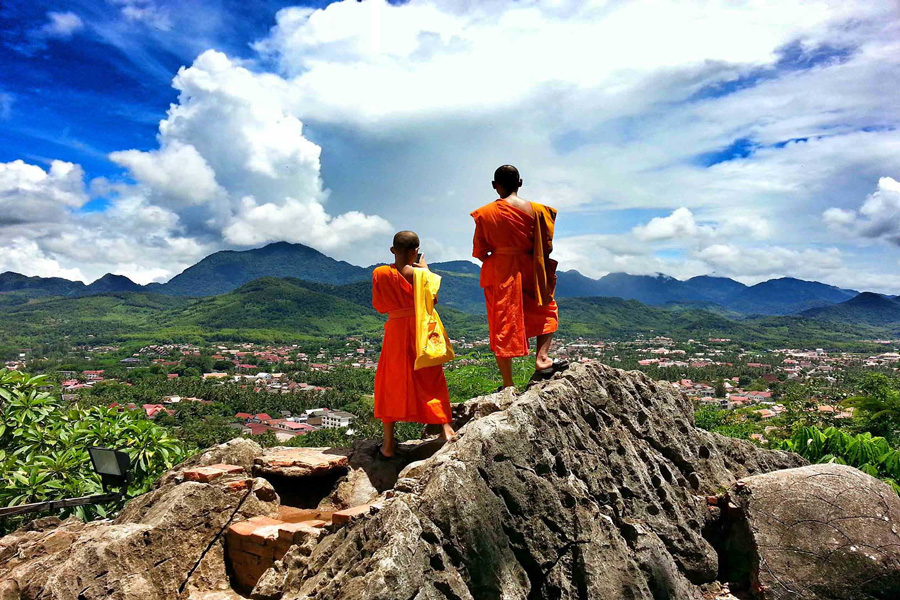
There are but a few things that can compare to the beautiful views from the top of Mount Phou Si.
Phou Si itself means sacred hill, as this is not an actual mountain but rather a hill that’s tall – about 100 meters.
Luang Prabang has a gorgeous skyline, and Mount Phou Si is definitely the best place to experience it.
It’s located in the centre of the old town, which makes it very easily accessible, but it does take a bit of a hike to get to the top.
There are over 300 stairs to reach to the top, but once you’re there, you’ll be glad you’ve put in the effort.
While the views are consistently amazing throughout the entire day, sunset is when the hill truly feels a magical spot.
You’ll be surrounded by golden pagodas, and just as the sun starts to set and the lights of the city flicker to life, you’ll get to experience something truly unforgettable.
Make sure to get to the top before the sun is about to set because the spot is very popular and there will definitely be crowds around.
6.Explore the city and its spirituality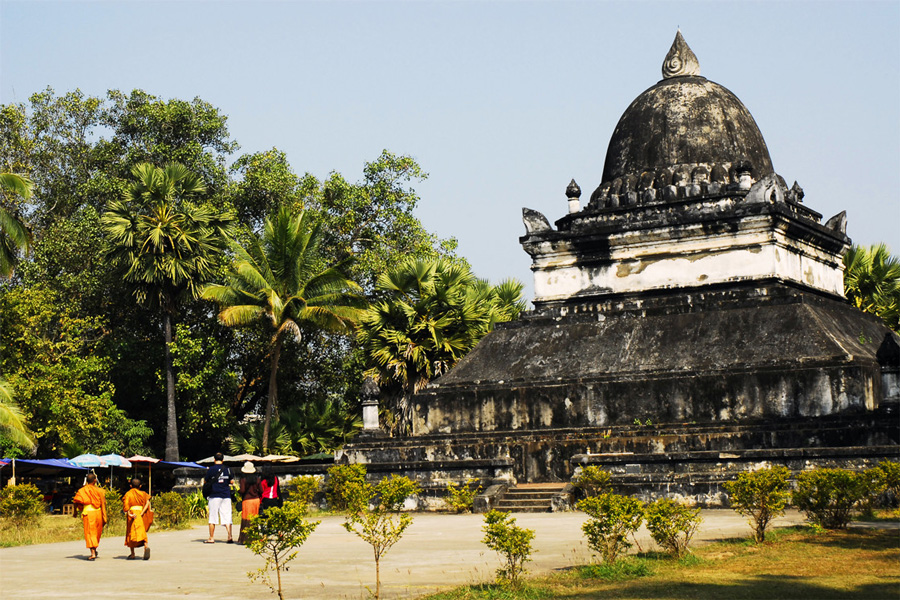
Wandering through old, historic neighbourhoods in the city is one of the best things to do in Luang Prabang.
When you’re stuck on what to see in Luang Prabang you can always set out to explore the pleasant French-laneways.
France had a significant presence in the past, which is why a lot of the architecture and general aesthetics have such a strong French undertone.
If walking for hours on end isn’t something you prefer, you can always rent a bike and just explore the place with it.
There’s plenty to see in the city, so you might want to spend a lot of time throughout the day doing nothing but sightseeing.
There are a few hills right on the outskirts of the town that are amazing to visit, especially on a bike, and they’re pretty easy to reach.
Although it’s generally considered safe to bike everywhere in Luang Prabang, make sure to wear your helmet and definitely get travel insurance.
If you feel you’re done with wandering and exploring, you can always sit down for a nice and relaxing spot of yoga.
Yoga is one of the best things to do in Luang Prabang as there is a cooperative of many independent yoga teachers with whom you can practice in the city’s most beautiful spots.
7.Learn history at the 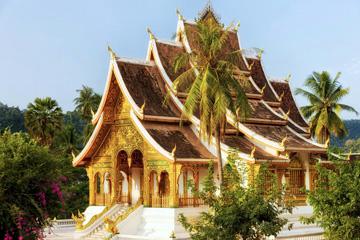
This museum was originally constructed as a residential palace for King Sisavang Vong in 1904.
It’s constructed with a blend of traditional Lao and French architecture, which is why it has such a unique aesthetic.
After the king’s death, the crown prince, Savang Vatthana, and his family occupied the palace.
They were the last to hold residence until the revolution of 1975.
When Laos no longer had a royal dynasty to rule the country, the government occupied the palace complex.
It was then reopened to the public in 1995 as a museum.
Since 1995, the Royal Palace Museum holds a significant number of artefacts and items from the past that each tell their own stories, which are part of the larger story of the country of Laos.
The complex is divided into three parts – the main palace and a few other buildings.
One of the other buildings in the complex is an ornate pavilion, which is known for housing a standing Buddha statue called Prabang, which the city is named after.
There is even a car collection in the compound, though it’s modest in size and it includes American cars from the 1950s to 1970s.
8.Learn how to cultivate rice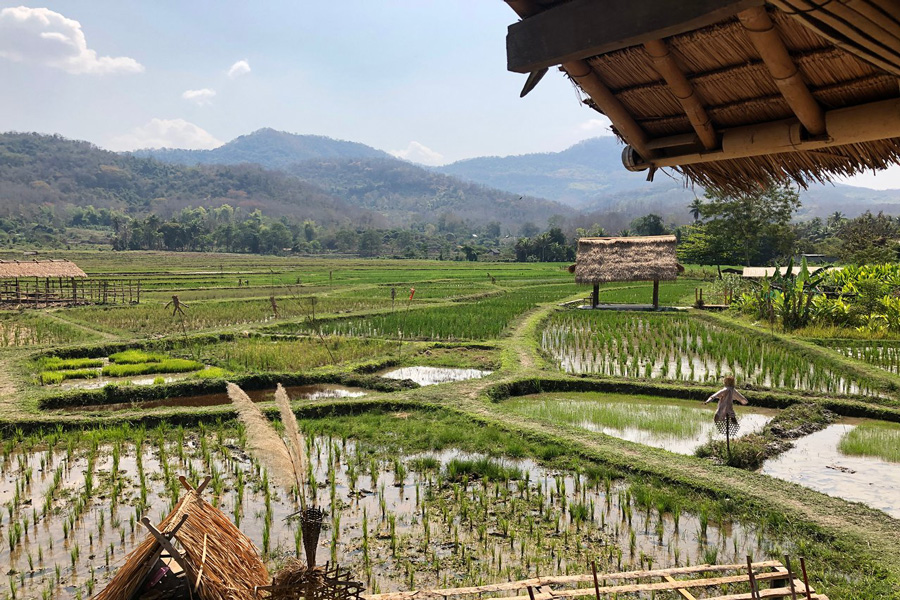
One of the things that Laos is known for, in general, is their rice and the sprawling rice fields it comes from.
It’s possible to become a rice farmer for one day over at the Living Land Organic Farm, where you’ll be able to try your hand at every single step of making rice manually.
No modern machinery is used on the farm as everything is done with hard work. You’ll be taught how to cultivate and grow rice the traditional way.
The entire process is far from glamorous, though, as one of the steps requires you to wade through fields of mud.
After you’re done for the day, you’ll come to appreciate just how much effort goes into making rice.
Rice has become a staple of Lao cuisine, and the main type of rice is called sticky rice.
This is just one of several hundred types of rice that grow in the region, and you’ll have an amazing opportunity to learn more about them at the farm.
As it’s such a big part of Laos culture, getting an opportunity to learn more about rice cultivation is perfect to complete your Luang Prabang sightseeing experience.
9.Cruise along the Mekong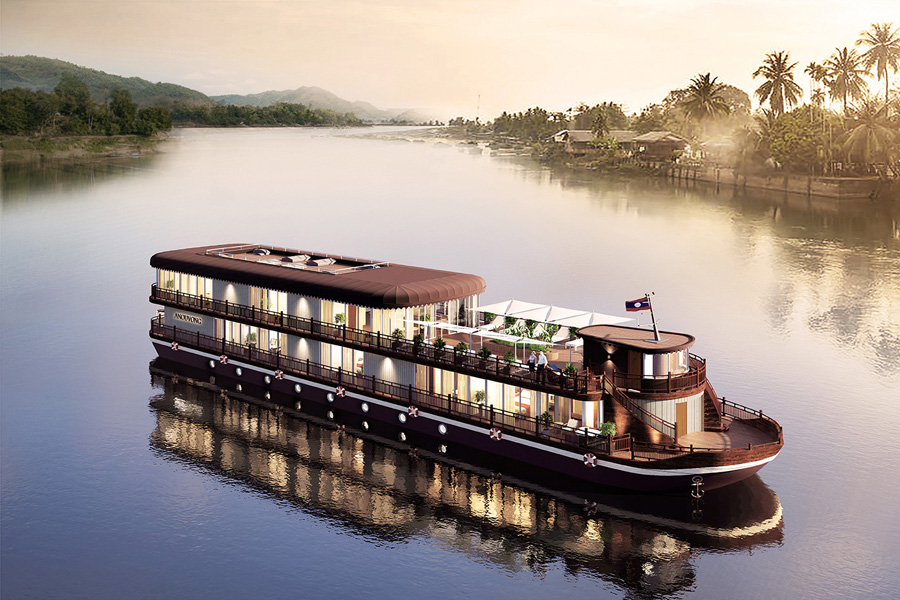
One of the best ways to experience the surroundings of Luang Prabang is to take a river cruise down the stunning Mekong.
It’s one of the best things to do in Luang Prabang, especially considering that you’ll be seeing a lot of the biggest highlights in the region.
What’s great about these tours is that there are plenty of options to choose from – from basic boats all the way to luxury vessels.
Touring the Mekong is best done right before sunset because then you’ll be able to truly enjoy the splendour of the surrounding nature, and you’ll be able to see the locals finishing up their daily routines.
There are three different spots to choose from, and several different companies, each with their own particular flavour.
You can take a short one-hour cruise, or you can even opt for a longer cruise to some of the farther sites like Pak Ou Caves.
10. See the Buddha Statues over at Pak Ou Caves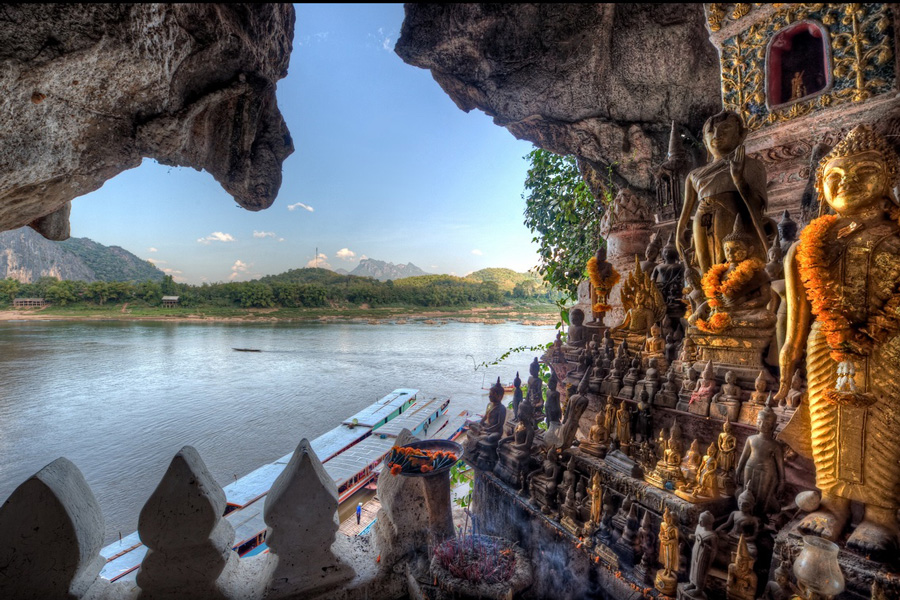
The famous Pak Ou Caves are one of the most important religious spots in the region, and they’re one of the most known prayer sites.
They’re most known for the thousands of different Buddha idols, all in different shapes and sizes, left throughout history by different people.
In the past, when the pilgrims first came and settled in this region, they visited the cave and left a Buddha statue, which prompted other pilgrims to start leaving Buddha idols of their own.
Today, both upper and lower caves are filled with these idols, and even though they appear as souvenirs, they’re actually very important religious idols.
The lower cave is well-lit and everything is clearly marked, so there will be no confusion as to where to go.
The upper cave is the one that’s slightly more difficult to reach, but only because you’ll need a torch to climb the many steep steps.
Once you’re at the top, you’ll get to experience the caves the way they were mean to be experienced, which is without a lot of tourists, and as a place for serenity and relaxation.
They’re quite easy to reach by boat.
11.Sample traditional whiskey at the Whiskey village
The Whiskey Village is one of the most popular Luang Prabang tourist attractions, and it’s often a stop when visiting the Pak Ou Caves by boat.
The whiskey itself is quite different from whiskey in the west, in that it’s made from rice with a very traditional method, but the end result is still a very potent alcoholic beverage.
Whiskey is called Lao-Lao, which is, in fact, two different words – the first means alcohol, and the second is the country.
Lao whiskey is almost entirely incorporated into the culture, as it’s used in a lot of traditions, so expect to be treated with samples generously.
If you do take a liking to the drink, there are bottles of this liquor on sale as well.
You can even observe how to make and prepare the whiskey, although it’s not encouraged to take part of the process and try to make it yourself.
Visiting here will not take a lot of your time, as you’ll most likely be heading to the Pak Ou Caves relatively shortly after arriving.
Sign up for a guided tour here and explore not just the Whiskey Village but also Pak Ou Caves and the Kuang Si Falls.
12.Take cooking classes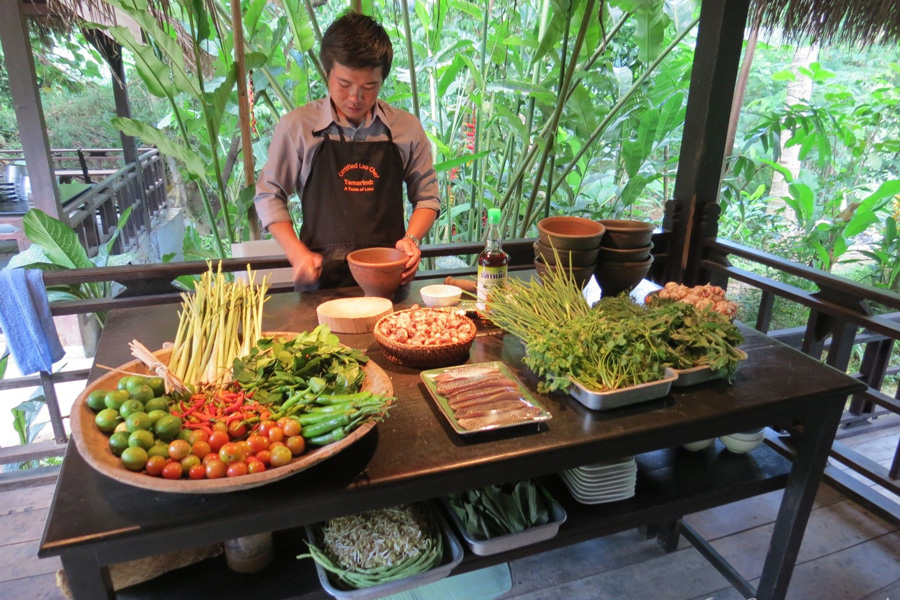
A lot of visitors to this part of Laos are surprised that one of the best things to see in Luang Prabang is actually the inside of a kitchen.
Tamarind’s cooking school is located just outside the city, but you’ll be picked up from the Tamarind restaurant in the city with a tuk-tuk and brought to the school.
Lao cuisine is absolutely exquisite and unique, and one of the first lessons is picking and choosing your ingredients at the market.
The school claims that only by knowing how each ingredient feels like, you’ll know how to properly prepare Lao dishes.
There are only a few other students in any given class, so you’ll receive more than enough attention and guidance on how to cook traditional meals.
13.Opt for an authentic Lao Massage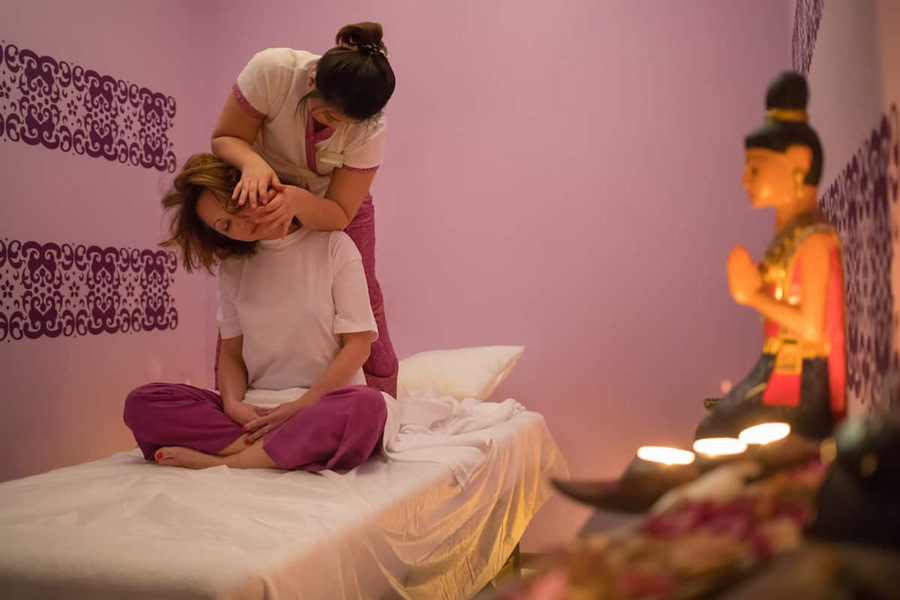
It’s true that Laos’ neighbours are the ones that are much more famous for their massages, but Lao massages are an entirely different experience.
If you’re looking for a typical relaxing massage in Luang Prabang, then don’t look for an authentic Lao massage, but rather ask for an oil massage.
An authentic massage is not as relaxing as other types of massages, but rather it’s meant to be a therapeutic experience that releases tension by focusing on key pressure points.
These massages are done while wearing sarongs or loose clothes.
It is important to note, however, that you might feel pain or discomfort at first.
There are several spas in Luang Prabang, but be wary of some of the cheaper ones, because you usually get what you pay for.
Some locals might not pay as much heed to hygiene as much as they should, so make sure to find a place that appears reputable and clean.
14.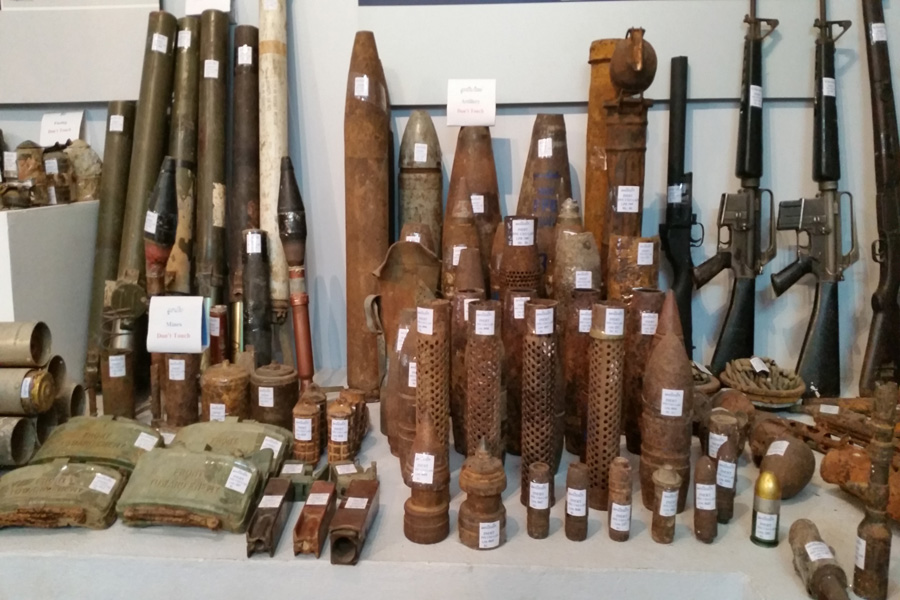
The history of Laos is not the most peaceful as the country had often been plagued with wars and revolutions.
During the ’60s and ’70s, before the revolution, Laos was continuously bombarded by ordnance and explosives.
Over the course of 9 years, there were more than 270 million bombs dropped on the country’s territory.
Laos is the world’s most bombed country per capita, and unexploded ordnance is still a live threat to this very day in most of the districts in the country.
This museum is dedicated to shedding light and raising awareness of the issue.
Even after extensive relief support, however, the issue still persists.
The museum is a chilling experience and is considered a Luang Prabang must see.
15.Go on an adventure in green jungle park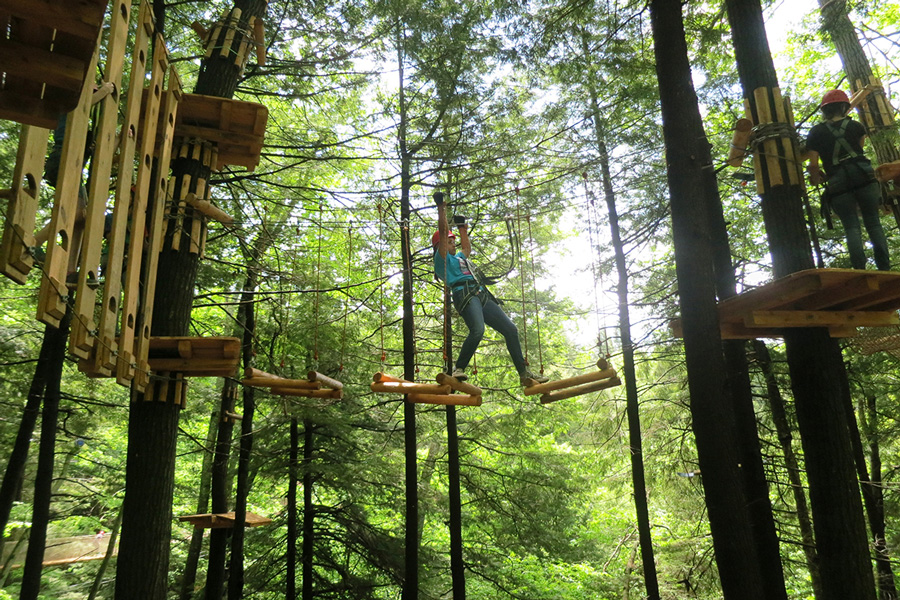
Before Green Jungle Park was formed as a spot for adventures, it used to be a rubbish dump, which has been fully reclaimed today.
The park is surrounded by a forest and a gorgeous cascade, where you’ll find a lot of zip lines, monkey bridges, and even rope courses.
It might not be that near to the city, but you’ll be able to get there by catching a boat from Luang Prabang behind the Royal Palace.
After you disembark from a 30-minute ride, you’ll be taxied for the rest of the way.
This is a great place to go if you’re not sure what to see in Laos as it’s located in one of the region’s lushest areas.
There’s a unique sense of adventure and you’re never that far away from civilisation.
Just getting out and exploring the streets of Luang Prabang is one of the best things to do here. Early morning and late afternoon light tend to be best for photographs and also keeps you out of the midday sun! As Laos first UNESCO World Heritage-listed location the city is well preserved and you’ll see a whole lot just by taking a walk! That said there are several must-dos in Luang Prabang and we think that these are them.
1.Luang prabang itinerary at-a-glance
A summary of the itinerary is as follows. Read on below for the finer details and practical information:
Day 1: self-guided bicycle tour of historic temples, lunch and relaxation in a local riverside bar, sunset boat trip on the Mekong, visit to the night market
Day 2: Kuang Si Waterfalls and bear sanctuary trip, Mount Phou Si viewpoint walk, tradition Lao BBQ dinner
Day 3: Chomphet hike on the riverbank, traditional Lao massage, dinner in a local charitable restaurant, night out at the bowling alley
2.3 days in Luang Prabang: the details
Day 1: relaxation and exploration
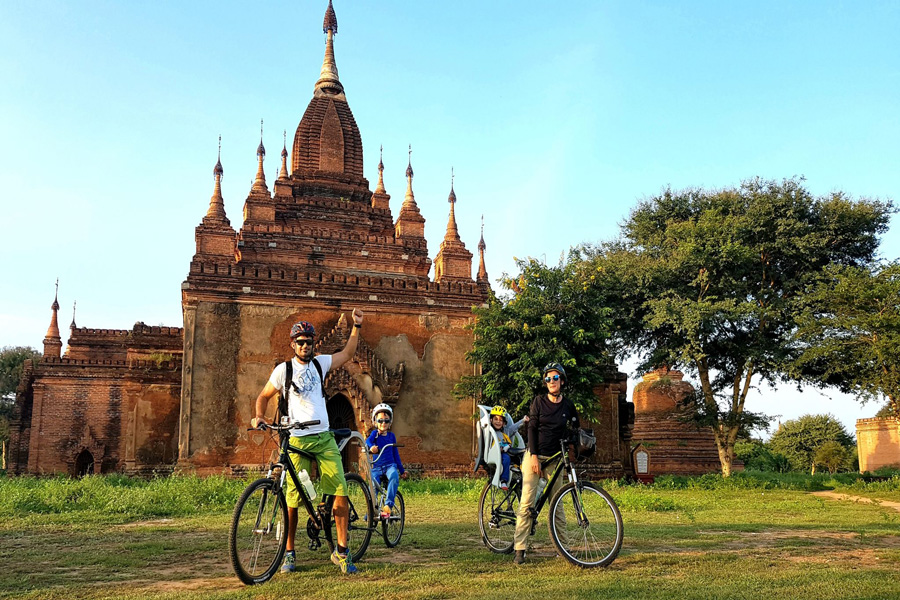
Morning: self-guided bicycle tour of historic temples
Luang Prabang’s city centre is a designated UNESCO World Heritage Site that includes 33 of the most sophisticated temples in Southeast Asia. Exploring these local treasures is a great way to get to know the city and find your way around.
These temples of Luang Prabang are located within a compact area that’s entirely possible to navigate on foot. We found it a lot easier and more fun to cycle, and recommend that you do too!
You can hire bicycles in the city centre for around 20,000–30,000 kip per day. The bikes usually come with a lock, but be sure to double-check this as you’ll need one.
This is our suggested route for seeing the best temples in Luang Prabang (you can also use the map below to create your own route):
+ Wat Phon Phao: a hilltop temple and forested Buddhist retreat about a 2.5-kilometres ride south-east from the city centre.
+ Wat Xieng Thong: the ‘monastery of the golden city’. a 16th-century temple and one of the most important in Laos. A 3.5-kilometre ride from Wat Phon Phao, including a scenic stretch along the Nam Khan river.
+ Wat Sop Sickaram: a beautifully ornate golden-fronted temple just a couple of hundred metres away from Wat Xieng Thong.
+ Wat Pa Phai: the ‘monastery of the bamboo forest’, a 19th-century wooden temple of red and gold surrounded by trees and blossoming flowers. Located about half a kilometre south-west of Wat Sop Sickaram along Sakkarine Road.
+ Wat Mahathat: the ‘temple of the great stupa’, a 16th-century temple restored in the early 20th century after storm damage. About a kilometre’s ride along Sisavangvong Road from Wat Pa Phai.
+ Wat Aham: the ‘monastery of the opened heart’, a small and serene temple built in 1818 on the site of a previous 16th-century worshipping structure. About a kilometre’s ride from Wat Mahathat towards the Nam Khan river.
+ That Makmo: the ‘watermelon stupa’, a beautiful weather-worn structure dating back to the early 16th century. Located right next to Wat Aham, and a short distance away from Utopia bar, our recommended spot for a late lunch.
Afternoon: late lunch and chill-out in Utopia bar
It’s time to give your legs a rest and have a relaxing late lunch in Utopia, a spacious bar and restaurant overlooking the Nam Khan river. This is the most popular hangout for backpackers in Luang Prabang.
The menu offers a mixture of classic Lao dishes and western favourites. Don’t feel guilty if you’re tempted by the pizzas (they’re very good) – there’s plenty of opportunity later in our itinerary to try traditional Lao cuisine.
Utopia’s lounge area along the riverfront is tailor-made for flaking out while your lunch digests. Grab a book, lie back on one of the cushioned mats and enjoy the serenity.
Evening: Mekong sunset tour
The huge, meandering Mekong river provides a stunning natural attraction on the doorstep of Luang Prabang. The river is an intrinsic part of the tapestry of life in the city.
One of the most fulfilling ways to experience the Mekong in Luang Prabang is to take a river cruise at sunset. You can pre-book a tour with GetYourGuide, which includes a basket of local food to enjoy on the boat.
As the sun goes down you will drift through scenes of thick forest and float past riverside villages, with green mountain peaks rising up in the distance. It’s a scene that’s perfectly accompanied by a bottle of Beerlao or Namkhong beer.
Before bed: dinner and shopping at the night market
After disembarking back in Luang Prabang, you will still have plenty of time to explore one of the city’s famous regular fixtures: the night market.
Every night from 5pm to 11pm the night market takes place along the main stretch of Sisavangvong Road and surrounding streets. Some 300 pop-up stalls sell local craft, arts, clothing and souvenirs under red and blue canvass.
Around the market you will find street food carts and seated cafés selling classic local dishes and delicacies. Indulge yourself in some real Lao food for dinner, and then walk it off as you peruse the market.
Day 2: sightseeing highlights

Morning: Kuang Si Waterfalls and bear sanctuary trip
The second day of our itinerary begins with a trip to Luang Prabang’s most iconic attraction: Kuang Si Waterfalls. This wonder of nature is a cascading waterfall system of picture-perfect turquoise tiered pools. Don’t forget to bring your camera; you’ll be needing it.
Pack your swimming gear before you go; one of the highlights of this trip is the chance to take a dip in those luscious clear pools. You can get changed in the cubicles on site.
There are several ways to get to the falls, which are located 30 kilometres south-west of Luang Prabang. You can hire a moped, or even cycle if you’re up for a challenge. We booked into a shared minivan, which was the most hassle-free option, and inexpensive at 30,000 kip each.
You will arrive in a small village where you will need to pay a 20,000 kip entrance fee to begin the short walk that leads to the falls. Along the way you will pass through the Tat Kuang Si Bear Rescue Centre and see Asiatic black bears at play. You can also buy merchandise to support the upkeep of the sanctuary (it doesn’t receive any money from the entrance fees).
Once you reach the pools you can easily while away an hour or two taking refreshing dips, admiring the spectacle and taking photos of the different perspectives. There are also some options to hike around the falls, with trails leading off into the dense jungle.
Once you’re satisfied, head back down to the village and grab some lunch in one of the small restaurants. Then it’s back to the city…
Afternoon/sunset: Mount Phou Si viewpoint walk
Don’t be put off by the fact that this is a ‘mount’ – it’s actually a very manageable walk up a series of stairways to the highest point in Luang Prabang.
Mount Phou Si is centrally located in the city (you can’t miss it, just look out for the big hill) and can be accessed by two main entrances. One is opposite the Royal Palace gates, and the other is around the far side by the Nam Khan river road.
There is an entrance fee of 20,000 kip that you will need to pay part-way up the hill. As you ascend you will see some interesting structures, including Wat Chom Si, a 19th-century temple, and a shrine of golden Buddhas and ornaments inside a small grotto.
The best panoramic views of Luang Prabang and the Mekong countryside await you at the top of the final flight of steps. It’s an extra-special sight at sunset, but also a highly popular one, so come earlier if you prefer to avoid the crowds.
Evening: traditional BBQ dinner at Lao Lao Garden
Your Laos cuisine experience won’t be complete until you’ve tried a traditional BBQ meal. At Lao Lao Garden in Luang Prabang, you can experience it in a rainforest-esque outdoor setting. You will find it on Phou Si road, just around the corner from Utopia; from outside it looks quite small, but stepping inside you emerge into layers of beautiful gardens.
If you order the BBQ, a plate of hot coals will be brought to your table. The friendly staff will then help you to cook your own meats, vegetables and eggs (yes, even eggs are barbecued in Laos!).
The service can be a little slow, but why rush? It’s a pleasant place to hang out, forget your worries and enjoy the atmosphere. We liked coming here just for a drink too, and there’s always a good cocktail deal on.
Day 3: hike and unwind
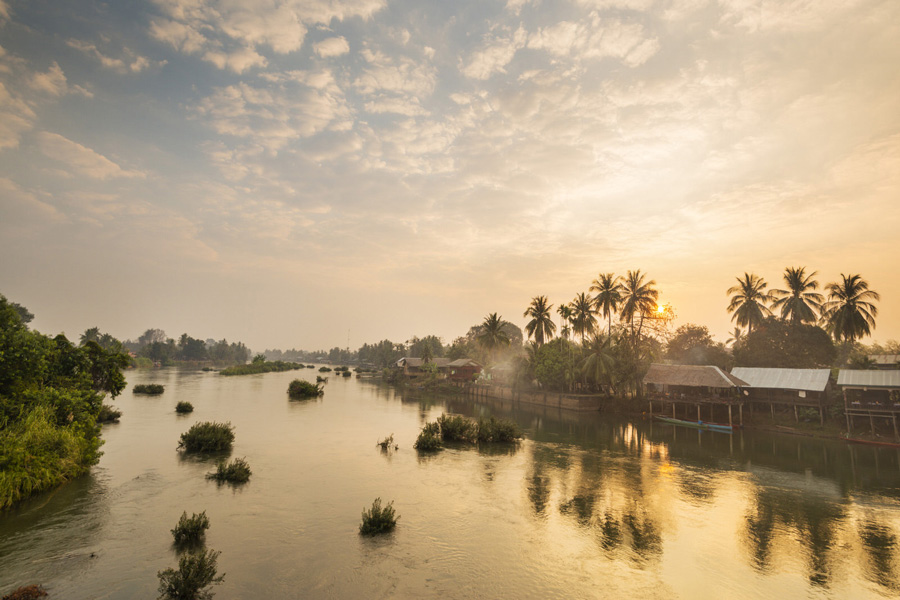
Morning: Chomphet hike on the riverbank
On the final day of our itinerary we venture across the Mekong river for a picturesque hike though forests and temples along the far bank.
The Chomphet hike begins at the small village of Ban Xieng Mane, which you can reach by taking a ferry boat from the main port by the Royal Palace. The trail then leads north-east tracing the riverbank, passing by five temples, which act as markers for the route. You will wander in and out of forestland and enjoy lovely views of Luang Prabang back across the river.
The hike typically takes 2–3 hours, so if you set off after breakfast you can avoid the midday heat and finish with a picnic lunch. This detailed guide to the hike by So Many Miles provides all the practical information you need to know.
Afternoon: relax with a Lao massage
After the morning’s hike you’ve earned some relaxation, and what better way to rest it off than with a traditional Lao massage?
Luang Prabang is packed with spas and massage parlours, many of which are mind-blowingly cheap. One of the best budget options is L’Hibiscus Spa on Sakkarine Road, where you can get a quality one-hour massage for just 60,000 kip.
Evening: dinner in a local charitable restaurant
Just outside the entrance to Utopia is a quaint local restaurant called Lao Friend Bar. We were drawn to this place when we learned about its back-story; it is run by two young men trying to raise money to rebuild their home village in northern Laos, after it was destroyed by flooding. Read our article on the Luang Prabang bar rebuilding a flood-damaged village for the full story.
We spent my birthday evening here, and liked it so much here we came back again the next night. The food is great – the best traditional Luang Prabang salad I had anywhere in Laos. Try the khao soi as well.
To finish: night out at the bowling alley
After your meal in Lao Friend Bar, head into Utopia for a few evening drinks before a trip to Luang Prabang’s legendary late-night bowling alley! (Yes, you read correctly.)
At 11pm, bars across the city close their doors adhering to the national curfew. The only place you can continue to have a drink is at a bowling alley, in an isolated neighbourhood a few kilometres out of town.
As you join the crowds leaving Utopia at closing time, you will be met outside by tuk-tuk drivers offering lifts to the bowling alley. It should cost 10,000 kip per person if you go in a group.
The bowling alley stays open until 2am, with alcohol flowing over the bar and even an archery range outside. It’s a little bizarre, but also a must-do to complete your Luang Prabang experience, and a great way to let your hair down at the end of your stay.
Or, if you’re anything like us, you could just go there every night…
1.Barbecued meats
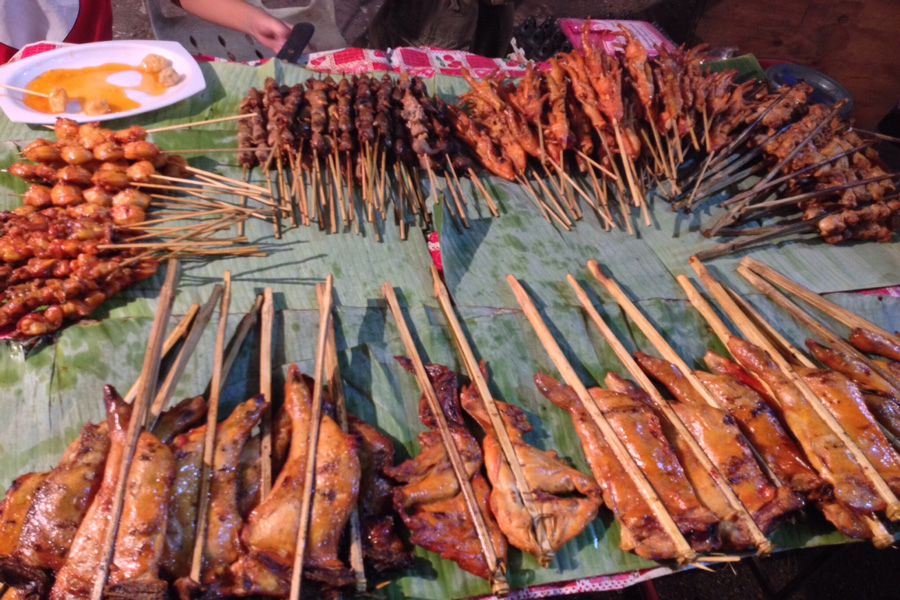
There are many stalls selling barbecued meats. But unlike elsewhere in Laos, the street food in Luang Prabang this has been adapted for foreigners.
In Laos, every part of the animal is eaten, so eating in a more local restaurant was hard for us (congealed pig’s blood in your noodle soup anyone? Or chunks of pork fat or other insides…?)
The meat at the night market is by far the best street food in Luang Prabang. It’s proper meat and it’s damn good.
2.Salted barbecued fish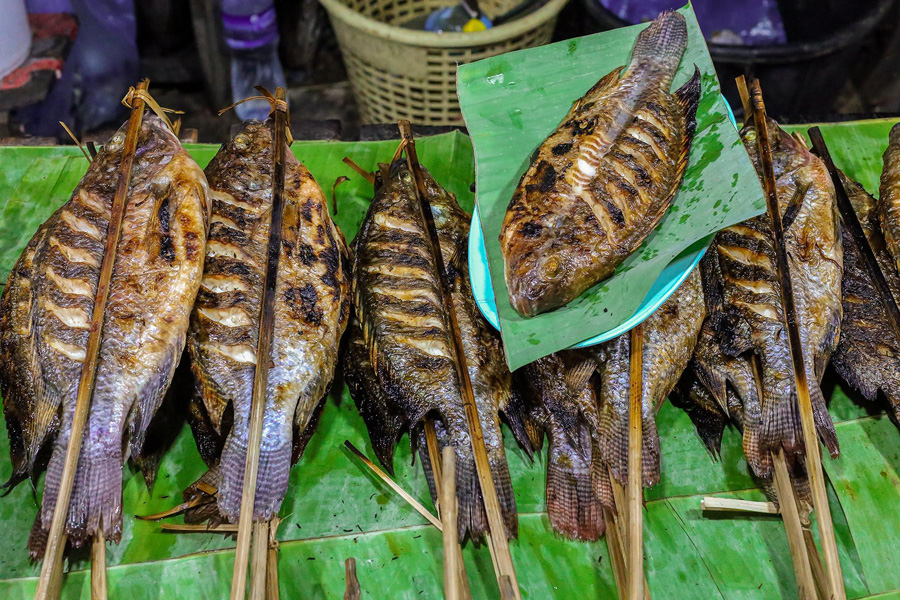
As well as barbecued meats, fish is a very popular street food in Luang Prabang. There is a selection of different sized fish, which have been marinated, salted and are then barbecued in front of you to make a very tasty meal.
3.Baguette sandwiches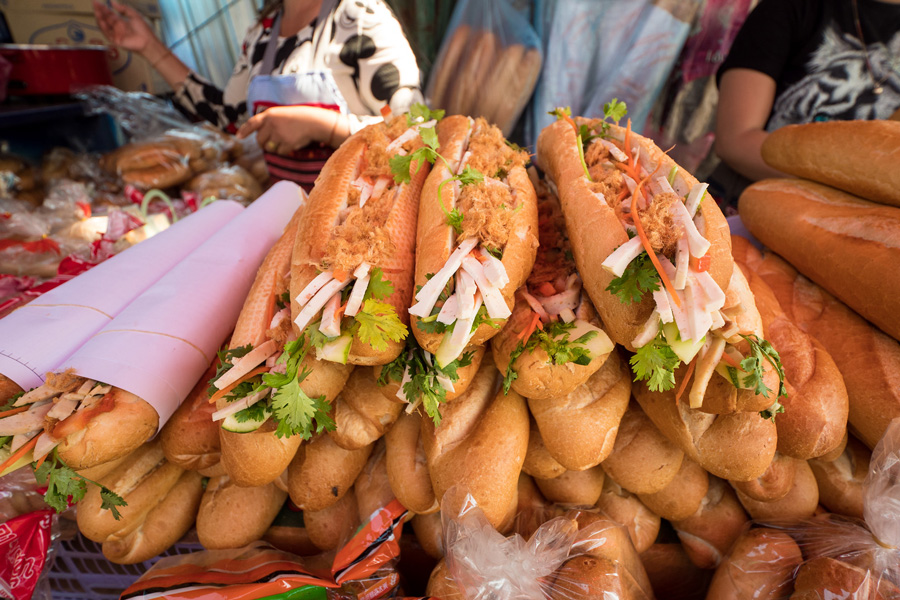
There are many colourful stalls selling various baguette sandwiches for as little as 10,000 kips each (84p / $1.30). This may not seem anything special, but in Asia where the carbohydrate staple is rice and noodles, you do miss good bread.
4.Noodle soup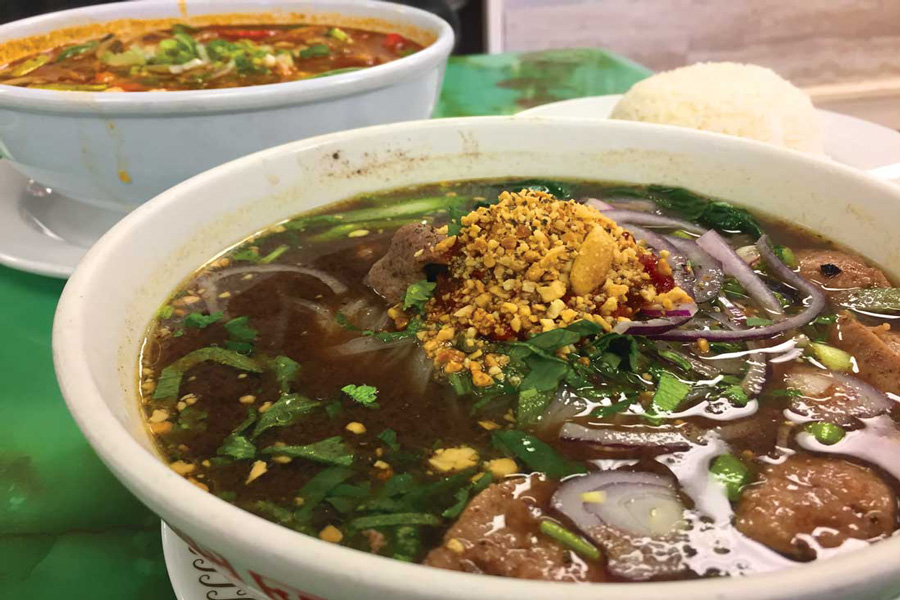
Noodle soup is staple street food in Luang Prabang and in Laos generally.
We struggled at first with it in the local restaurants because of the variety of very questionable meats used. This is not the case at the night market, which has been adapted for foreigners and contains proper meat.
5.Exotic fruits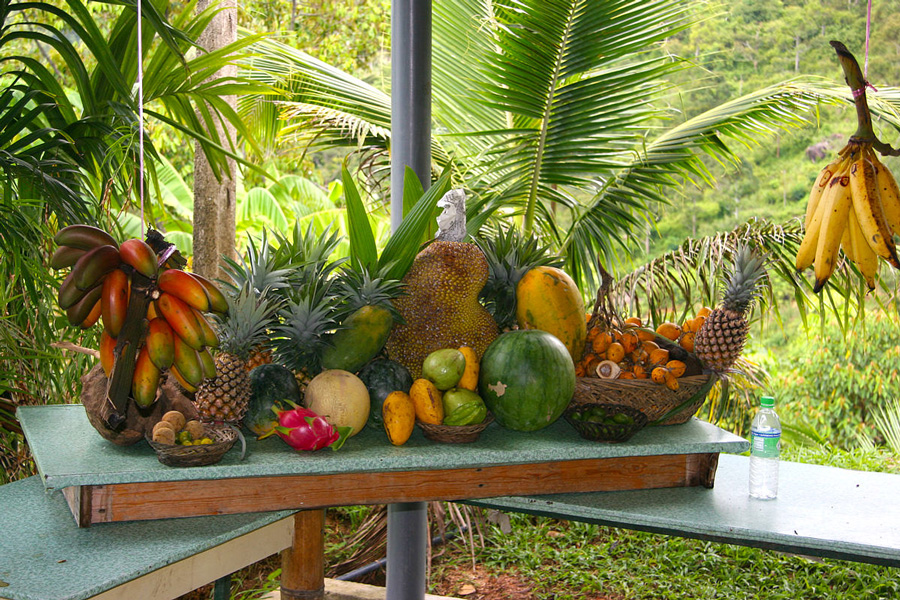
Tropical fruit is one our favourite foods whilst travelling in Asia and the street food market in Luang Prabang is abundant with them. Mangos were particularly unique as these are home grown in Laos, sweet and plentiful.
6.Sugar cane juice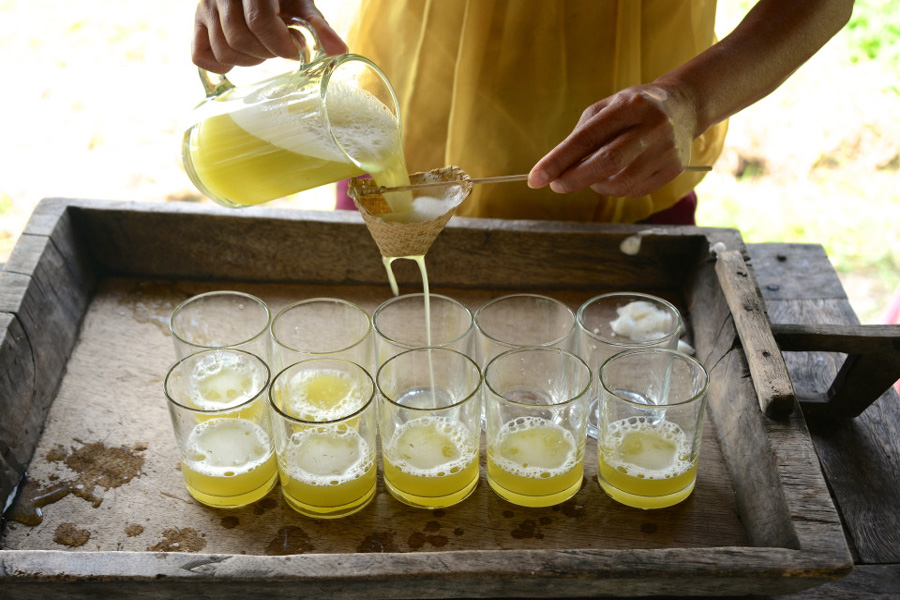 Sugar cane was our exciting ‘discovery’ from the street food in Yangon, Myanmar. It is available everywhere in Luang Prabang street stalls.
Sugar cane was our exciting ‘discovery’ from the street food in Yangon, Myanmar. It is available everywhere in Luang Prabang street stalls.
The juice is squeezed out and then served in a small plastic bag with a straw to drink it.
7.Spicy papaya salad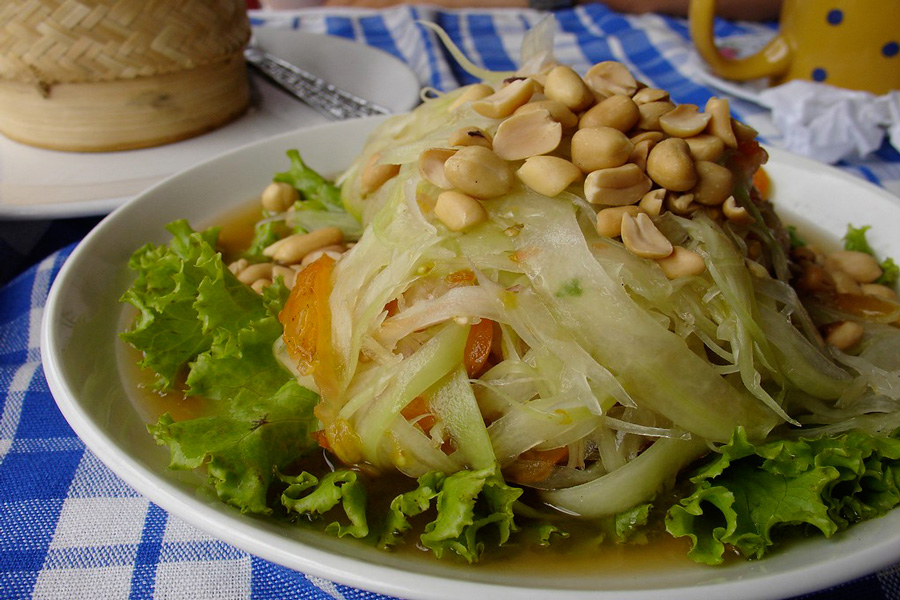
Som tam is the Thai take on the spicy papaya salad. We found out this healthy salad originated from Laos and called tam maak hoong.
Papaya salad is a very popular street food in Luang Prabang, made from green papaya with a cucumber like consistency, lots of lime juice, chilli and fish sauce. There are many stalls dotted around the night market and in Laos generally where it is prepared and sold.
8.Kanom krok (coconut rice pancakes)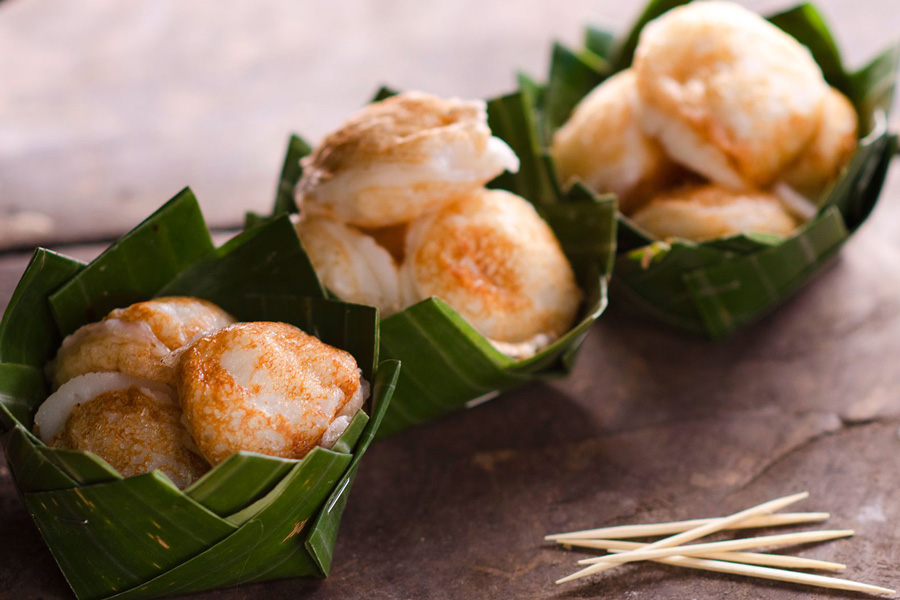 Kanom krok are small pancakes like desserts made from coconut milk, sugar, sticky rice and flour. They are cooked in the kanom krok cast iron pans.
Kanom krok are small pancakes like desserts made from coconut milk, sugar, sticky rice and flour. They are cooked in the kanom krok cast iron pans.
9.Fried spring rolls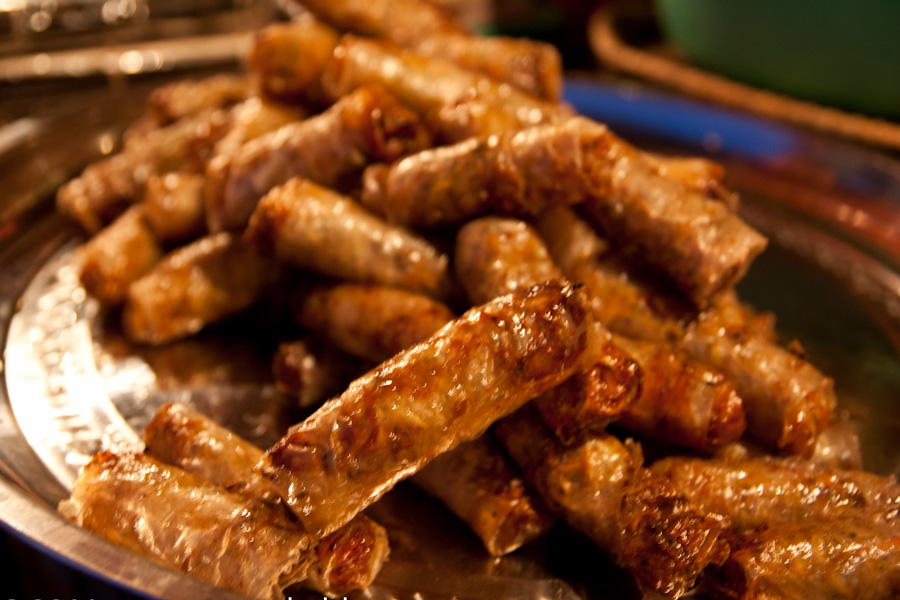
There are a few stalls at the night market making freshly made fried spring rolls both meat and vegetarian. They are sold in packets of around 5 for 10,000 kips (84p / $1.3) each.
Spring rolls are popular throughout Asia, but the ones sold as street food in Luang Prabang particularly resonated with us.
10.Fried dumplings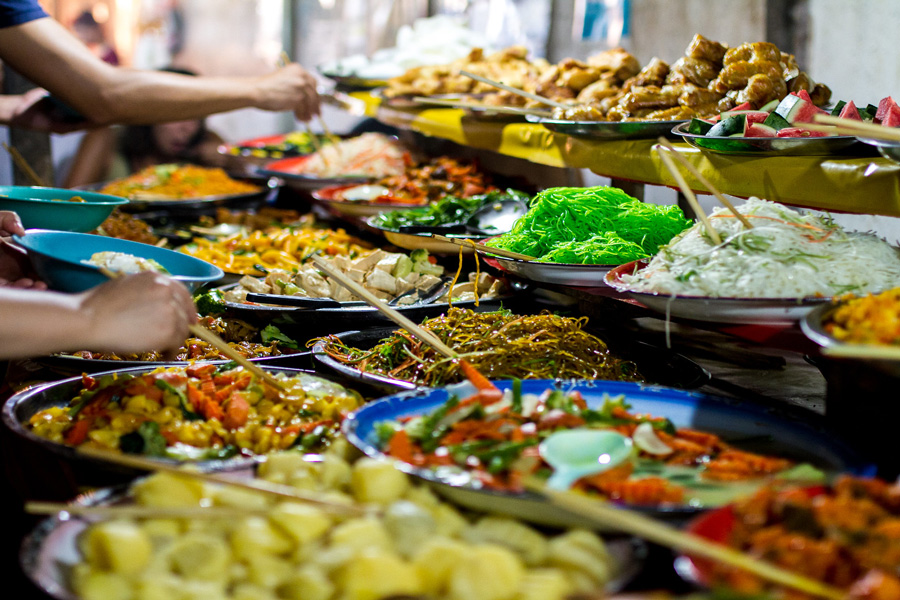
One very friendly man works alongside his wife at the street food market of Luang Prabang. She prepares the noodle soup and he prepares the fried dumplings.
Just like the spring rolls, meat and vegetarian ones are freshly made and sold. A spicy sauce is given as an accompaniment to give it a kick.
The weather in Luang Prabang is typical of many Southeast Asian countries – the city enjoys a tropical climate with warm weather year-round, with temperatures ranging between 15°C and 38°C. The rainy season in Luang Prabang is from June to September, while the dry season falls between October and May.
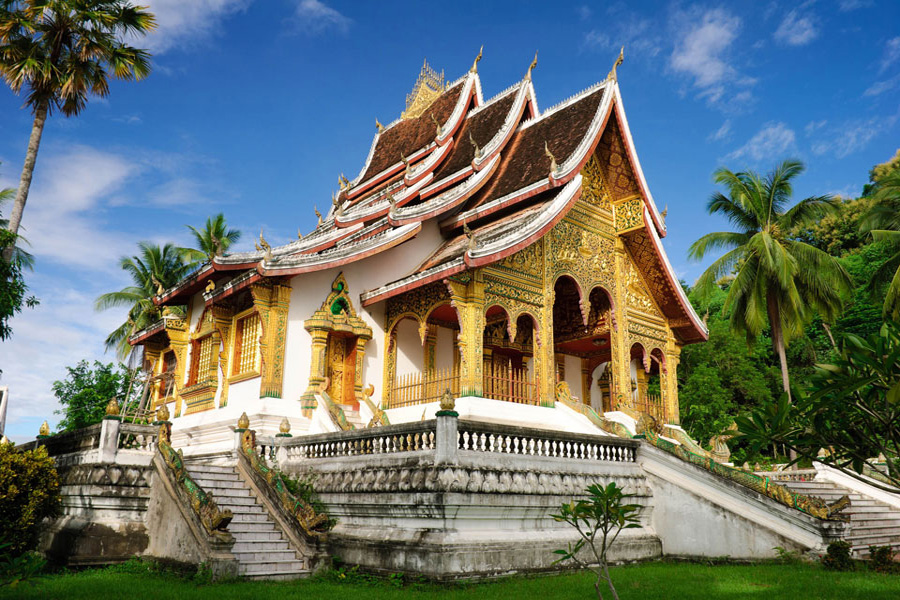
The best time to visit Luang Prabang is from November to March when the weather is comfortably dry with pleasant average temperatures. It can also get somewhat crowded, especially in January and during festivals, so be sure to book ahead if you’re travelling during this time of the year.
The northeast monsoon brings cooler temperatures to the city from November to May, while heavy rainfall comes with the southwest monsoon from June to September. Luang Prabang’s annual rainfall is 1,300 mm, with August generally being the wettest month.

Downpours usually last for only short periods, but the Mekong River may get flooded in August and September. March to May is the hottest time of year when Luang Prabang experiences high levels of humidity and high average temperatures.
Luang Prabang is exceptional for both its rich architectural and artistic heritage that reflects the fusion of Lao traditional urban architecture with that of the colonial era. Its remarkably well-preserved townscape reflects the alliance of these two distinct cultural traditions. The old town center of Luang Prabang is classified as a UNESCO World Heritage Site since 1995 for its outstanding cultural, historic and architectural values and its harmonious relationship between the natural and built environment.
Luang Prabang is clearly the supermodel of Laos and to that end, it certainly has been manicured to appeal to western tourists; for some, this will be part of its charm, whereas for others, it will be off-putting.
Pick any side street and you’ll be treated to unexpected delights that reward present awareness – a beautiful garden, a breathtaking river view, the ancient stones of a temple, the handmade artistry of a silversmith.
You may also like
Treasures of Laos
- Depart Time:Daily
- Starts/Ends:Luang Prabang/Vientiane
- Tour type:Private Tours
- Travel Style:Nature & Adventure, Heritage Tours, Culture & History
- Activities:Local culture tours, Cultural, religious and historic sites tours, Countryside and village visits tours, City sightseeing tours
- Suitable for:Solo, Family, Group, Couple
- Age range:1 To 90 Years
- Operated in:English, French, Spanish, German, Italian
Highlights of Laos Tour
- Depart Time:Daily
- Starts/Ends:Luang Prabang/Pakse
- Tour type:Private Tours
- Travel Style:Nature & Adventure, Heritage Tours, Culture & History
- Activities:Local culture tours, Cultural, religious and historic sites tours, Countryside and village visits tours, City sightseeing tours
- Suitable for:Solo, Family, Group, Couple
- Age range:1 To 90 Years
- Operated in:English, French, Spanish, German, Italian
World Heritage Explorer Laos
- Depart Time:Daily
- Starts/Ends:Vientiane/Luang Prabang
- Tour type:Private Tours
- Travel Style:Heritage Tours, Family Tours, Culture & History
- Activities:Sightseeing Tours, Local culture tours, Cultural, religious and historic sites tours, Countryside and village visits tours
- Suitable for:Solo, Family, Group, Couple
- Age range:1 To 90 Years
- Operated in:English, French, Spanish, German, Italian
Best of Laos Tour 7 Days
- Depart Time:Daily
- Starts/Ends:Vientiane/Luang Prabang
- Tour type:Private Tours
- Travel Style:Nature & Adventure, Heritage Tours, Culture & History
- Activities:Local culture tours, Cultural, religious and historic sites tours, Countryside and village visits tours, City sightseeing tours
- Suitable for:Solo, Family, Group, Couple
- Age range:1 To 90 Years
- Operated in:English, French, Spanish, German, Italian
Highlights of Laos 6 Days
- Depart Time:Daily
- Starts/Ends:Vientiane/Luang Prabang
- Tour type:Private Tours
- Activities:Local culture tours, Cultural, religious and historic sites tours, Countryside and village visits tours, City sightseeing tours
- Suitable for:Solo, Family, Group, Couple
- Age range:1 To 90 Years
- Operated in:English, French, Spanish, German, Italian
Highlights Of Southern Laos 10 Days
- Depart Time:Daily
- Starts/Ends:Vientiane/Pakse
- Tour type:Private Tours
- Travel Style:Nature & Adventure, Heritage Tours, Culture & History
- Activities:Local culture tours, Cultural, religious and historic sites tours, Countryside and village visits tours, City sightseeing tours
- Suitable for:Solo, Family, Group, Couple
- Age range:1 To 90 Years
- Operated in:English, French, Spanish, German, Italian
 France
France  Spain
Spain  German
German  Italian
Italian 







 Vietnam Tours
Vietnam Tours  Cambodia Tours
Cambodia Tours  Myanmar tours
Myanmar tours  Thailand Tours
Thailand Tours  Laos Tours
Laos Tours